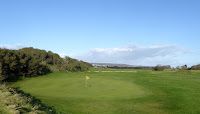www.aberdoveygolf.co.uk/
Gold tees 6036 yards, 69.6, slope 124
Orange tees 5797 yards, 74.4, slope 138
Set on the north of the estuary of the River Dovey in the natural beauty of the Snowdonia National Park in west Wales, Golf was reputedly played here in the 1880s by Arthur Ruck, an infantry officer,. He used Aberdovey Common, an area of ground between the railway and the sea and planted nine flower pots as holes. Among his playing partners was Bernard Darwin, the grandson of the great naturalist who would holiday with his Welsh grandmother. She did not play golf but gave the club its motto - an old Welsh proverb 'if you can't be strong, be cunning' which perfectly encapsulated the course. Bernard went on to be an acclaimed golf writer but never lost his love for Aberdovey which he wrote was 'the course that my soul loved best of all the courses in the world'. Several famous golf architects have shaped the course including Herbert Fowler, Harry Colt and James Braid, making it into the iconic links it is today.
 |
The second green with the railway
in the background |
We played Aberdovey with Lynn and David Lawson on a sunny day with a strong easterly wind. Like a classic links course it runs more or less straight out and straight back in, with a small zig zag at the turn, much like the Old Course at St Andrews. With the prevailing wind being west to south-west it will normally be behind the golfer on the way out and against on the way in, leading perhaps to a false sense of security at the start of the round! It lies on a narrow strip of land between the railway and sand dunes and reminded us of Brancaster or Goswick.
 |
The third green is over a large dune,
hence the name Cader |
The first four holes run along the dunes on the left. The first two have narrow fairways with trouble on both sides. The third is a blind par 3 over a large dune after which it is named - Cader for the local mountain Cader Idris. The green lies in a hollow beyond. The par 4 fourth has a long carry from its high tee and is followed by a par 3 which heads towards the railway line. The green is sloping and has a ditch in front of it requiring an accurate shot. The next three holes are classic links holes with the eighth, although a short par 4, being defended by nine bunkers short of and around the green. The par 3 ninth turns at right angles to the dunes with two large bunkers guarding the green. The next two holes are long par 4s, the tenth heading back in the direction of the clubhouse and the 11th going in the opposite direction. A par 3, the twelfth has a green high on a sand dune with lovely views of the beach to the right and steep banking front and left. The next three holes run back towards home, with the thirteenth being a particularly lovely par 5. There is a tight drive on the short par 4 sixteenth as it is very close to the railway on the left. The green is set into the dunes with a steep runoff on left. The finishing hole is challenging if you tend to hook the ball with water, rough and out of bounds on the left.
 |
| The 18th green and clubhouse |
 |
| The par 3 12th |
Worth playing? Definitely - it is links heaven.













































